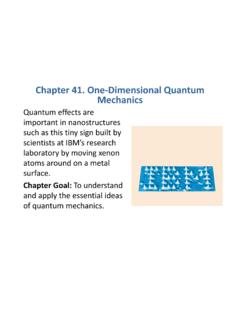Transcription of The electronic properties of graphene
1 The electronic properties of grapheneA. H. Castro NetoDepartment of physics , Boston University, 590 Commonwealth Avenue, Boston,Massachusetts 02215, USAF. GuineaInstituto de Ciencia de Materiales de Madrid, CSIC, Cantoblanco, E-28049 Madrid, SpainN. M. R. PeresCenter of physics and Department of physics , Universidade do Minho, P-4710-057,Braga, PortugalK. S. Novoselov and A. K. GeimDepartment of physics and Astronomy, University of Manchester, Manchester, M13 9PL,United Kingdom Published 14 January 2009 This article reviews the basic theoretical aspects of graphene , a one-atom-thick allotrope of carbon,with unusual two-dimensional Dirac-like electronic excitations.
2 The Dirac electrons can be controlledby application of external electric and magnetic fields, or by altering sample geometry and/or Dirac electrons behave in unusual ways in tunneling, confinement, and the integer quantum Halleffect. The electronic properties of graphene stacks are discussed and vary with stacking order andnumber of layers. Edge surface states in graphene depend on the edge termination zigzag orarmchair and affect the physical properties of nanoribbons. Different types of disorder modify theDirac equation leading to unusual spectroscopic and transport properties .
3 The effects ofelectron-electron and electron-phonon interactions in single layer and multilayer graphene are number s : , r, , Introduction110II. Elementary electronic properties of Graphene112A. Single layer: Tight-binding approach1121. Cyclotron mass1132. Density of states114B. Dirac fermions1141. Chiral tunneling and Klein paradox1152. Confinement andZitterbewegung117C. Bilayer graphene : Tight-binding approach118D. Epitaxial graphene119E. graphene stacks1201. electronic structure of bulk graphite121F.
4 Surface states in graphene122G. Surface states in graphene stacks124H. The spectrum of graphene nanoribbons1241. Zigzag nanoribbons1252. Armchair nanoribbons126I. Dirac fermions in a magnetic field126J. The anomalous integer quantum Hall effect128K. Tight-binding model in a magnetic field128L. Landau levels in graphene stacks130M. Diamagnetism130N. Spin-orbit coupling131 III. Flexural Phonons, Elasticity, and Crumpling132IV. Disorder in Graphene134A. Ripples135B. Topological lattice defects136C. Impurity states137D.
5 Localized states near edges, cracks, and voids137E. Self-doping138F. Vector potential and gauge field disorder1391. Gauge field induced by curvature1402. Elastic strain1403. Random gauge fields141G. Coupling to magnetic impurities141H. Weak and strong localization142I. Transport near the Dirac point143J. Boltzmann equation description of dc transport indoped graphene144K. Magnetotransport and universal conductivity1451. The full self-consistent Born approximation FSBA 146V. Many-Body Effects148A.
6 Electron-phonon interactions148B. Electron-electron interactions1501. Screening in graphene stacks152C. Short-range interactions1521. Bilayer graphene : Exchange1532. Bilayer graphene : Short-range interactions154D. Interactions in high magnetic fields154VI. Conclusions154 Acknowledgments155 References155 REVIEWS OF MODERN physics , VOLUME 81, JANUARY MARCH 20090034-6861/2009/81 1 /109 54 2009 The American Physical Society109I. INTRODUCTIONC arbon is themateria primafor life and the basis of allorganic chemistry.
7 Because of the flexibility of its bond-ing, carbon-based systems show an unlimited number ofdifferent structures with an equally large variety ofphysical properties . These physical properties are, ingreat part, the result of the dimensionality of thesestructures. Among systems with only carbon atoms, graphene a two-dimensional 2D allotrope ofcarbon plays an important role since it is the basis forthe understanding of the electronic properties in otherallotropes. graphene is made out of carbon atoms ar-ranged on a honeycomb structure made out of hexagons see , and can be thought of as composed of ben-zene rings stripped out from their hydrogen atoms Pauling, 1972.
8 Fullerenes Andreoni, 2000 are mol-ecules where carbon atoms are arranged spherically, andhence, from the physical point of view, are zero-dimensional objects with discrete energy can be obtained from graphene with the in-troduction of pentagons that create positive curvaturedefects , and hence, fullerenes can be thought aswrapped-up graphene . Carbon nanotubes Saitoet al.,1998;Charlieret al., 2007 are obtained by rollinggraphene along a given direction and reconnecting thecarbon bonds. Hence carbon nanotubes have only hexa-gons and can be thought of as one-dimensional 1D ob-jects.
9 Graphite, a three dimensional 3D allotrope ofcarbon, became widely known after the invention of thepencil in 1564 Petroski, 1989 , and its usefulness as aninstrument for writing comes from the fact that graphiteis made out of stacks of graphene layers that are weaklycoupled by van der Waals forces. Hence, when onepresses a pencil against a sheet of paper, one is actuallyproducing graphene stacks and, somewhere amongthem, there could be individual graphene layers. Al-though graphene is the mother for all these differentallotropes and has been presumably produced everytime someone writes with a pencil, it was only isolated440 years after its invention Novoselovet al.
10 , 2004 . Thereason is that, first, no one actually expected grapheneto exist in the free state and, second, even with the ben-efit of hindsight, no experimental tools existed to searchfor one-atom-thick flakes among the pencil debris cov-ering macroscopic areas Geim and MacDonald, 2007 . graphene was eventually spotted due to the subtle op-tical effect it creates on top of a chosen SiO2substrate Novoselovet al., 2004 that allows its observation withan ordinary optical microscope Abergelet al., 2007;Blakeet al.









